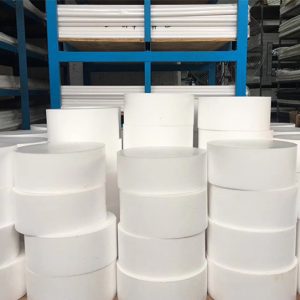The friction coefficient of PTFE

The Friction Coefficient of PTFE is Extremely Small
The friction coefficient of PTFE is extremely small, only 1/5 of that of polyethylene, which is an important characteristic of the fluorocarbon surface. Due to the extremely low intermolecular forces between fluorine-carbon chain molecules, PTFE has non-stick properties.
PTFE maintains excellent mechanical properties over a wide temperature range of -196 to 260℃, and one of the characteristics of fluorocarbon polymers is that they do not become brittle at low temperatures.
PTFE has a high density of 2.14-2.20g/cm3, is almost non-absorbent, and has an equilibrium water absorption rate of less than 0.01%. PTFE is a typical soft and weak polymer, with small intermolecular attractive forces, low stiffness, hardness, and strength, and will deform under long-term stress.
PTFE is prone to creep under load and is a typical plastic with cold flow properties. The creep of PTFE varies with different compressive stresses, temperatures, and degrees of crystallinity, and increases with increasing temperature. The creep of PTFE is less than 2% when the degree of crystallinity is between 55% and 80%, and increases rapidly when the degree of crystallinity is below 55% or above 80%.
The excellent mechanical property of PTFE is its small friction coefficient, which is between 0.01 and 0.10, the smallest among existing plastic materials and even all engineering materials.
The friction of PTFE increases with increasing sliding speed, and tends to stabilize when the linear speed reaches 0.5-1.0m/s or higher. The static friction coefficient of PTFE is smaller than the dynamic friction coefficient. Using this characteristic in bearing manufacturing can reduce the starting resistance and make it run smoothly from start to finish.
The friction coefficient of PTFE decreases with increasing load, and tends to be constant when the load reaches 0.8 MPa or higher. Under high speed and high load, the friction coefficient of PTFE is less than 0.01. The friction coefficient of PTFE remains almost unchanged from ultra-low temperature to its melting point, and only increases sharply when the surface temperature is higher than the melting point. Due to the small intermolecular attractive forces, low hardness of PTFE, it is easily worn by other materials. However, as long as the surface roughness of the wear material is suitable, the wear of PTFE can be reduced to a considerable extent.

Leave a Reply